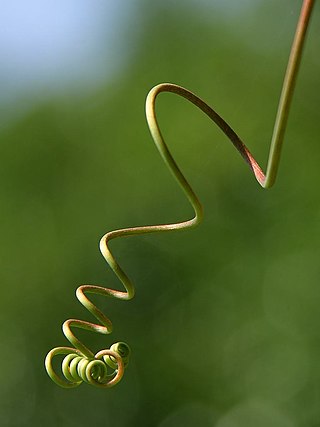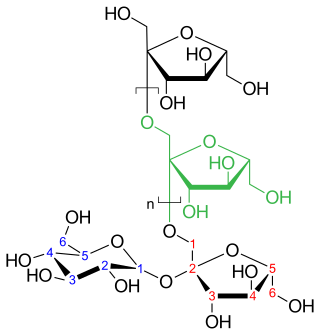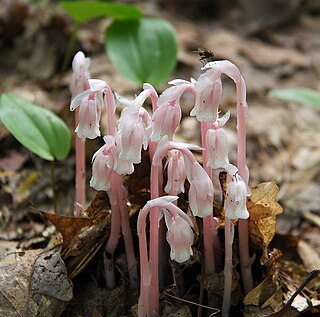Related Research Articles

A mycorrhiza is a symbiotic association between a fungus and a plant. The term mycorrhiza refers to the role of the fungus in the plant's rhizosphere, its root system. Mycorrhizae play important roles in plant nutrition, soil biology, and soil chemistry.

Aquatic plants are plants that have adapted to living in aquatic environments. They are also referred to as hydrophytes or macrophytes to distinguish them from algae and other microphytes. A macrophyte is a plant that grows in or near water and is either emergent, submergent, or floating. In lakes and rivers macrophytes provide cover for fish, substrate for aquatic invertebrates, produce oxygen, and act as food for some fish and wildlife.

The Embryophyta, or land plants, are the most familiar group of green plants that comprise vegetation on Earth. Embryophytes have a common ancestor with green algae, having emerged within the Phragmoplastophyta clade of green algae as sister of the Zygnematophyceae. The Embryophyta consist of the bryophytes plus the polysporangiophytes. Living embryophytes therefore include hornworts, liverworts, mosses, lycophytes, ferns, gymnosperms and flowering plants. The land plants have diplobiontic life cycles and it is accepted now that they emerged from freshwater, multi-celled algae.

In botany, a tendril is a specialized stem, leaf or petiole with a threadlike shape used by climbing plants for support and attachment, as well as cellular invasion by parasitic plants such as Cuscuta. There are many plants that have tendrils; including sweet peas, passionflower, grapes and the Chilean glory-flower. Tendrils respond to touch and to chemical factors by curling, twining, or adhering to suitable structures or hosts. Tendrils vary greatly in size from a few centimeters up to 27 inches for Nepenthes harryana The chestnut vine can have tendrils up to 20.5 inches in length. Normally there is only one simple or branched tendril at each node, but the aardvark cucumber can have as many as eight.

Crassulacean acid metabolism, also known as CAM photosynthesis, is a carbon fixation pathway that evolved in some plants as an adaptation to arid conditions that allows a plant to photosynthesize during the day, but only exchange gases at night. In a plant using full CAM, the stomata in the leaves remain shut during the day to reduce evapotranspiration, but they open at night to collect carbon dioxide and allow it to diffuse into the mesophyll cells. The CO2 is stored as four-carbon malic acid in vacuoles at night, and then in the daytime, the malate is transported to chloroplasts where it is converted back to CO2, which is then used during photosynthesis. The pre-collected CO2 is concentrated around the enzyme RuBisCO, increasing photosynthetic efficiency. This mechanism of acid metabolism was first discovered in plants of the family Crassulaceae.
A tracheid is a long and tapered lignified cell in the xylem of vascular plants. It is a type of conductive cell called a tracheary element. Angiosperms use another type of conductive cell, called vessel elements, to transport water through the xylem. The main functions of tracheid cells are to transport water and inorganic salts, and to provide structural support for trees. There are often pits on the cell walls of tracheids, which allows for water flow between cells. Tracheids are dead at functional maturity and do not have a protoplast. The wood (softwood) of gymnosperms such as pines and other conifers is mainly composed of tracheids. Tracheids are also the main conductive cells in the primary xylem of ferns.

C4 carbon fixation or the Hatch–Slack pathway is one of three known photosynthetic processes of carbon fixation in plants. It owes the names to the 1960s discovery by Marshall Davidson Hatch and Charles Roger Slack that some plants, when supplied with 14CO2, incorporate the 14C label into four-carbon molecules first.

The apoplast is the extracellular space outside of plant cell membranes, especially the fluid-filled cell walls of adjacent cells where water and dissolved material can flow and diffuse freely. Fluid and material flows occurring in any extracellular space are called apoplastic flow or apoplastic transport. The apoplastic pathway is one route by which water and solutes are transported and distributed to different places through tissues and organs, contrasting with the symplastic pathway.

A fructan is a polymer of fructose molecules. Fructans with a short chain length are known as fructooligosaccharides. Fructans can be found in over 12% of the angiosperms including both monocots and dicots such as agave, artichokes, asparagus, leeks, garlic, onions, yacón, jícama, barley and wheat.

Myco-heterotrophy is a symbiotic relationship between certain kinds of plants and fungi, in which the plant gets all or part of its food from parasitism upon fungi rather than from photosynthesis. A myco-heterotroph is the parasitic plant partner in this relationship. Myco-heterotrophy is considered a kind of cheating relationship and myco-heterotrophs are sometimes informally referred to as "mycorrhizal cheaters". This relationship is sometimes referred to as mycotrophy, though this term is also used for plants that engage in mutualistic mycorrhizal relationships.
Ecophysiology, environmental physiology or physiological ecology is a biological discipline that studies the response of an organism's physiology to environmental conditions. It is closely related to comparative physiology and evolutionary physiology. Ernst Haeckel's coinage bionomy is sometimes employed as a synonym.
George Dickie was a Scottish botanist, who specialised in algae.
Porteresia coarctata is a species of grass in the family Poaceae, native to India, Sri Lanka, Bangladesh, and Myanmar.
Maintenance respiration refers to metabolism occurring in an organism that is needed to maintain that organism in a healthy, living state. Maintenance respiration contrasts with growth respiration, which is responsible for the synthesis of new structures in growth, nutrient uptake, nitrogen (N) reduction and phloem loading, whereas maintenance respiration is associated with protein and membrane turnover and maintenance of ion concentrations and gradients.

Jane Alison Langdale, is a British geneticist and academic. She is Professor of Plant Development in the Department of Biology at the University of Oxford and a Professorial Fellow at The Queen's College, Oxford.

Paul Gordon Jarvis was a leading ecologist and Professor of Forestry and Natural Resources at the University of Edinburgh from 1975 to 2001.
Orchid mycorrhizae are endomycorrhizal fungi which develop symbiotic relationships with the roots and seeds of plants of the family Orchidaceae. Nearly all orchids are myco-heterotrophic at some point in their life cycle. Orchid mycorrhizae are critically important during orchid germination, as an orchid seed has virtually no energy reserve and obtains its carbon from the fungal symbiont.
Some types of lichen are able to fix nitrogen from the atmosphere. This process relies on the presence of cyanobacteria as a partner species within the lichen. The ability to fix nitrogen enables lichen to live in nutrient-poor environments. Lichen can also extract nitrogen from the rocks on which they grow.

Catherine Ellen Lovelock is an Australian marine ecologist, whose research focuses on coastal ecosystems. She is a professor in the School of Biological Science at the University of Queensland and 2020 Georgina Sweet Australian Laureate Fellow.
Erika Jeannine Edwards is a professor at Yale University known for her work on evolution of plants. She is also the director of the Marsh Botanical Garden.
References
- 1 2 3 "RAVEN, Prof. John Albert" . Who's Who . Vol. 2016 (online Oxford University Press ed.). Oxford: A & C Black.(Subscription or UK public library membership required.)
- ↑ "Royal Society of Edinburgh Fellows as of 2016-05-13" (PDF). Edinburgh: Royal Society of Edinburgh. Archived from the original (PDF) on 30 March 2016.
- 1 2 3 "Certificate of election EC/1990/28: Raven, John Albert". London: Royal Society. Archived from the original on 31 March 2016.
- 1 2 3 4 "Professor John Raven FRS". London: Royal Society. Archived from the original on 17 November 2015. One or more of the preceding sentences incorporates text from the royalsociety.org website where:
“All text published under the heading 'Biography' on Fellow profile pages is available under Creative Commons Attribution 4.0 International License.” -- "Royal Society Terms, conditions and policies". Archived from the original on 25 September 2015. Retrieved 9 March 2016.
{{cite web}}: CS1 maint: bot: original URL status unknown (link) - ↑ "Professor John Raven". University of Technology Sydney. Archived from the original on 4 September 2014.
- ↑ Lüttge, Ulrich; Beyschlag, Wolfram; Francis, Dennis (2013). Progress in Botany. ISBN 9783642309670.
- ↑ "Profile John A. Raven", New Phytologist, vol. 215, pp. 514–515, 2017, retrieved 19 September 2023
- ↑ "Bioenergetics and the major evolutionary transitions". The Royal Society. Retrieved 23 March 2013.
- ↑ "Keynote Presentations at the GREENCYCLES II Summer School". Potsdam Institute for Climate Impact Research. Archived from the original on 9 March 2016. Retrieved 23 March 2013.
- ↑ "Professor John Raven FRS FRSE: Interactions among resources in the growth of phytoplankton". dundee.ac.uk. 30 August 2013. Archived from the original on 10 September 2015.
- 1 2 3 4 "Symposium to mark retiral of Professor John Raven". University of Dundee. 11 September 2008. Archived from the original on 31 March 2016. Retrieved 23 March 2013.
- ↑ Smith, Harry (2013). "Paul Gordon Jarvis, FRS: co-founding editor ofPlant, Cell & Environment". Plant, Cell & Environment. 36 (5): 907–908. doi: 10.1111/pce.12080 . ISSN 0140-7791. PMID 23421651.
- ↑ Smith, Harry (1978). "Editorial". Plant, Cell and Environment. 1 (1): 1. doi:10.1111/j.1365-3040.1978.tb00738.x. ISSN 0140-7791.
- ↑ Raven, John A. (2015). "Harry Smith, FRS: co-founding editor and first Chief Editor ofPlant, Cell & Environment". Plant, Cell & Environment. 38 (8): 1453–1454. doi: 10.1111/pce.12567 . ISSN 0140-7791. PMID 25991437.
- ↑ "Wiley-Blackwell Announces Retirement of Bob Campbell". wiley.com. 28 February 2013. Archived from the original on 30 March 2016.
- ↑ Raven, J.A. (1970). "Exogenous inorganic carbon sources in plant photosynthesis". Biological Reviews of the Cambridge Philosophical Society. 45 (2): 167–220. doi:10.1111/j.1469-185X.1970.tb01629.x. S2CID 86332656.
- ↑ Raven, J.A. (2000). "Land plant biochemistry". Philosophical Transactions of the Royal Society of London B. 355 (1398): 833–846. doi:10.1098/rstb.2000.0618. PMC 1692786 . PMID 10905612.
- ↑ Raven, J.A.; Hurd, C.L. (2012). "Ecophysiology of photosynthesis in macroalgae". Photosynthesis Research. 113 (1–3): 105–125. doi:10.1007/s11120-012-9768-z. PMID 22843100. S2CID 5744231.
- ↑ Raven, J.A.; Wollenweber, B.; Handley, L.L. (1992). "Ammonia and ammonium fluxes between photolithotrophs and the environment in relation to the global nitrogen-cycle". New Phytologist. 121 (1): 5–18. doi: 10.1111/j.1469-8137.1992.tb01087.x .
- ↑ Raven, J.A.; Yin, Z.H. (1998). "The past, present and future of nitrogenous compounds in the atmosphere, and their interactions with plants". New Phytologist. 139 (1): 205–219. doi: 10.1046/j.1469-8137.1998.00168.x .
- ↑ O'Malley-James, J. T.; Raven, J. A.; Cockell, C. S.; et al. (2012). "Life and Light: Exotic Photosynthesis in Binary and Multiple-Star Systems". Astrobiology. 12 (2): 115–124. arXiv: 1110.3728 . Bibcode:2012AsBio..12..115O. doi:10.1089/ast.2011.0678. PMID 22283409. S2CID 43997271.
- ↑ John Albert Raven's publications indexed by the Scopus bibliographic database. (subscription required)
- ↑ Raven, J.A. (1984). Energetics and Transport in Aquatic Plants (1 ed.). Krieger Publishing Company. ISBN 0-8451-2203-7.
- ↑ Falkowski, P.G.; Raven, J.A. (2007). Aquatic Photosynthesis (2 ed.). Princeton University Press. ISBN 978-0-632-06139-6.
- ↑ Raven, J. A. et al. (2005). Ocean acidification due to increasing atmospheric carbon dioxide. Royal Society, London, UK.
- ↑ Raven, John A.; Beardall, John (2016). "The ins and outs of CO2". Journal of Experimental Botany. 67 (1): 1–13. doi:10.1093/jxb/erv451. PMC 4682431 . PMID 26466660.
- ↑ "Transactions of the Botanical Society of Edinburgh". 45 (2). 1987: 163–165. doi:10.1080/03746608708685428.
{{cite journal}}: Cite journal requires|journal=(help) - ↑ "Award of Excellence". Phycological Society of America. Retrieved 1 April 2016.
- ↑ "Honorary Life Member of the British Phycological Society". University of Dundee. 20 August 2013. Retrieved 1 April 2016.